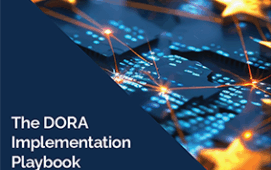
The International Organization of Securities Commissions (IOSCO) released a key thematic review in February 2025. The report examines how Market Authorities (MAs) – supervisory authorities/regulators, trading venues and self-regulatory organizations (SROs) – around the world have implemented surveillance recommendations first established in 2013.
This latest review specifically addresses regulators’ ability to oversee trading activities across multiple venues and to effectively collaborate across borders. Here’s what compliance leaders and regulators need to know:The latest IOSCO review, formally titled ” Thematic Review on Technological Challenges to Effective Market Surveillance Issues and Regulatory Tools,” assesses the progress regulators and SROs have made since IOSCO’s initial recommendations in 2013.
The review focuses primarily on two recommendations:
- Recommendation 1 calls on market authorities to ensure sufficient surveillance capacity across various trading venues and asset classes, particularly in highly automated markets.
- Recommendation 8 highlights the need for clear, effective cross-border surveillance protocols and collaboration among international regulators.
Key Findings at a Glance
The review finds notable improvements globally since 2013, but significant gaps remain:
Inconsistent Cross-Venue Surveillance: IOSCO notes that nearly 30% of regulators reported they still struggle to integrate data effectively across multiple trading platforms. This limits their ability to detect market misconduct across fragmented trading venues.
Algorithmic Trading Visibility Challenges: A substantial number of jurisdictions continue facing challenges in accurately identifying algorithmic trading. Regulators often lack tools and processes necessary to effectively monitor high-frequency trading (HFT), weakening oversight.
Insufficient Surveillance Funding and Resources: About 25% of surveyed jurisdictions stated that surveillance operations are underfunded and understaffed. This shortfall limits their capacity to maintain effective monitoring in increasingly complex and automated trading environments.
Limited Cross-Border Surveillance Protocols: The review identified weak cross-border collaboration among regulators. Many jurisdictions have not established clear, documented protocols or adequately mapped their surveillance capabilities, creating international surveillance blind spots.
The IOSCO report reveals significant disparities in surveillance maturity within and across regions:
Europe and North America: Generally, these regions demonstrated advanced surveillance systems. However, IOSCO found persistent challenges in effectively integrating data from multiple trading venues. Regulators in these regions also expressed difficulty accurately identifying and tracking algorithmic orders and trades.Asia-Pacific and Emerging Markets: In contrast, the review highlights more fundamental gaps in these regions. Regulators often cited limited funding and resources as major hurdles. Challenges included outdated or inadequate technology and weaker real-time surveillance capabilities. Additionally, cross-border collaboration remains particularly underdeveloped in these markets.
IOSCO’s Four Priority Recommendations
To address these persistent gaps, IOSCO outlined four clear priorities for immediate improvement:
Enhanced Cross-Venue Data Integration: IOSCO stresses that regulators must prioritize integrated data collection from multiple trading venues. This integration ensures comprehensive oversight, enabling faster identification and response to market misconduct.
Real-Time Algorithmic Trade Tracking: IOSCO urges regulators to significantly upgrade their analytical capabilities. Enhanced real-time analytics are critical for accurately tracking algorithmic and high-frequency trades across fragmented venues.
Regular Surveillance Model Calibration: The review emphasizes the importance of routine calibration of surveillance models. Periodic updates to these models, aligned with market structure changes – such as the introduction of new trading venues or increased retail trading – are crucial to maintaining surveillance effectiveness.
Strengthened Cross-Border Collaboration Protocols: IOSCO calls for clearer, standardized protocols to facilitate cross-border surveillance. Jurisdictions must proactively map their capabilities and create documented collaboration agreements to mitigate regulatory gaps that allow misconduct to go undetected internationally.
IOSCO’s thematic review provides MAs with a clear benchmark. It advises jurisdictions to conduct self-assessments against IOSCO’s recommendations. Specifically, IOSCO highlights that regulators should:
- Systematically identify gaps in data processing, analytical capabilities, and technology infrastructure.
- Review and adjust staffing levels to ensure adequate surveillance resources are allocated.
- Develop and document robust inter-agency and international collaboration frameworks, specifying clear escalation paths for cross-border investigations.
Looking Ahead
A section of the Review touches on additional supervisory or surveillance activities regulators use to monitor market activity that makes reference to the evolving challenges in monitoring electronic communications (e-comms). This is particularly relevant with the rise of “social trading” on platforms like WhatsApp and Signal. While many firms assert robust e-comms surveillance capabilities, regulatory enforcement actions suggest that there is considerable room for improvement. The encrypted and informal nature of such communications often places them outside traditional surveillance mechanisms, leading to potential gaps in oversight. IOSCO emphasizes the need for regulators to adapt their supervisory tools and methodologies to address these emerging channels effectively. This includes developing capabilities to detect and analyse trading activities coordinated through private messaging apps, ensuring that surveillance keeps pace with technological advancements in communication.As noted earlier, regulatory bodies have cited limited resources and funding as significant obstacles to effective market surveillance. This persistent challenge raises a key question – could proactive, collective action from market participants themselves be part of the solution? After all, it’s the markets that usually picks up all or a large part of the bill for new regulatory infrastructure. Industry associations and standard-setting bodies have historically stepped up to support regulatory oversight. For example, organizations such as the Securities Industry and Financial Markets Association (SIFMA) regularly advocate for standardized approaches to regulatory technology and compliance.
Subscribe to our newsletter




